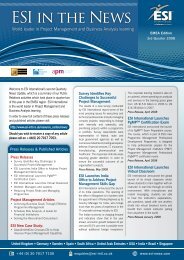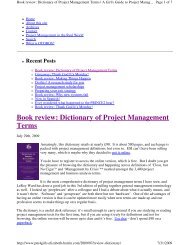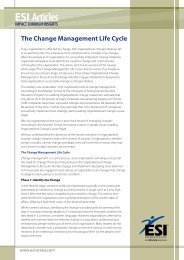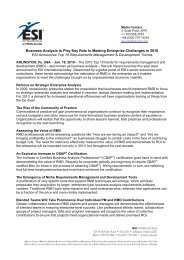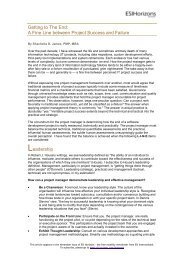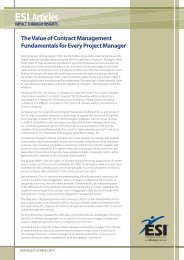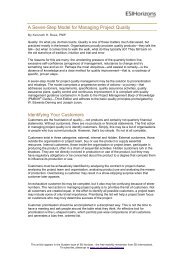Establishing Clear Project Management Guidelines - ESI International
Establishing Clear Project Management Guidelines - ESI International
Establishing Clear Project Management Guidelines - ESI International
Create successful ePaper yourself
Turn your PDF publications into a flip-book with our unique Google optimized e-Paper software.
<strong>Establishing</strong> <strong>Clear</strong> <strong>Project</strong><br />
<strong>Management</strong> <strong>Guidelines</strong><br />
by Michael S. Zambruski, PMP<br />
When I come into an organisation that has<br />
never used formal business analysis or<br />
project management processes, one of<br />
my first challenges is to address the uncertainty<br />
and confusion over some key concepts and<br />
tools. For example, almost immediately after I<br />
start meeting with decision-makers, I encounter<br />
questions like these:<br />
• What is the difference between the business<br />
vision, mission and goals?<br />
• How does the business requirements document<br />
(BRD) differ from the project charter?<br />
• Why do we need a project charter?<br />
• Why create a<br />
statement of<br />
work (SOW) if<br />
you already have<br />
the BRD?<br />
• Do we really<br />
need all of these<br />
processes in<br />
order to get a<br />
project going?<br />
Although these questions are rhetorical to a<br />
professional business analyst or project manager,<br />
they betray a fundamental absence of structured,<br />
disciplined process management by those who ask<br />
them. My task then becomes clear: I must provide<br />
education on the value of formal processes and<br />
procedures by packaging them into digestible<br />
and relevant concepts, techniques and artefacts.<br />
Toward that end I have developed the following<br />
four tools:<br />
• Hierarchy of business targets<br />
• Statement of work template<br />
• <strong>Project</strong> management guidelines<br />
• Glossary of terms<br />
“what is the difference between<br />
the business vision, mission<br />
and goals?”<br />
Hierarchy of Business Targets<br />
The hierarchy of business targets, shown in Figure<br />
1 on the next page, serves to orient the decisionmaker<br />
or team leader in the logical process of how<br />
work should progress from the idea stage to the<br />
implementation stage, with a clear indication at each<br />
step of what the deliverables are. For example, in<br />
the business domain—which I refer to as the area<br />
above the yellow line—we deal with the vision (TO<br />
BE state) of the business, the mission (AS IS state)<br />
and the various specific goals that support the vision<br />
and mission.<br />
Below the yellow line<br />
is the project domain,<br />
which is where the more<br />
abstract elements of<br />
vision, mission and goal<br />
come down to earth and<br />
evolve into concrete<br />
work tasks. The project<br />
charter is shown as the<br />
authorizing document<br />
that specifies both a<br />
project number (presumably assigned by a central<br />
control organization for tracking purposes) and<br />
the funding authorization. It basically sanctions<br />
the commitment of resources to formally plan and<br />
conduct collection of business requirements, which<br />
first involves the requirements work plan (RWP) and<br />
then culminates in production of the BRD.<br />
Once the charter, RWP and BRD are complete, the<br />
analysis phase of the project is finished and the<br />
organization has a clear understanding of exactly<br />
why it has approved this project and how the final<br />
deliverables will benefit the business. This is a critical<br />
step for managing and controlling subsequent efforts,<br />
which are now specified in the statement of work.<br />
GULF PROJECT MANAGEMENT MAGAZINE | SEPTEMBER 2007 | WWW.PMI-AGC.COM<br />
49
<strong>Establishing</strong> <strong>Clear</strong> <strong>Project</strong> <strong>Management</strong> <strong>Guidelines</strong><br />
Fig. 1 - Hierarchy of Business Targets<br />
BUSINESS<br />
GOAL A<br />
BUSINESS<br />
GOAL B<br />
BUSINESS<br />
VISION<br />
The TO BE State of the Enterprise<br />
BUSINESS<br />
VISION<br />
The TO BE State of the Enterprise<br />
BUSINESS<br />
GOAL C<br />
BUSINESS<br />
GOAL D<br />
BUSINESS<br />
GOAL E<br />
B<br />
U D<br />
S O<br />
I M<br />
N A<br />
E I<br />
S N<br />
S<br />
Initiation Phase of <strong>Project</strong> =<br />
> project number<br />
> funding authorization<br />
<strong>Project</strong> Charter<br />
for achieving<br />
BUSINESS GOAL C<br />
Business Requirements<br />
for achieving<br />
BUSINESS GOAL C<br />
= Analysis Phase of the <strong>Project</strong><br />
> Business Requirements Work Plan (RWP)<br />
> Business Requirements Dosument (BRD)<br />
Planning Phase of <strong>Project</strong> =<br />
CONTENTS<br />
Approach<br />
Tactics<br />
Priorities<br />
Progress Milestones<br />
In vs. Out of Scope<br />
Success Criteria<br />
- deliverables<br />
- traceability matrix<br />
- quality metrics<br />
Assumptions<br />
Constraints<br />
<strong>Project</strong> Statement of Work (SOW)<br />
for achieving<br />
BUSINESS GOAL C<br />
CONTENTS<br />
Detailed <strong>Project</strong> Budget<br />
<strong>Project</strong> Team Roster<br />
Comprehensive <strong>Project</strong> Plan<br />
Risk <strong>Management</strong> Plan<br />
Escalation Policy<br />
Communications Plan<br />
Documentation Protocol<br />
Test Strategy<br />
Training Strategy<br />
NEXT - <strong>Project</strong> Execution, Control, and Closure<br />
<strong>Project</strong> Goal = achieve Business Requirements in BRD<br />
P<br />
R<br />
O<br />
J<br />
E<br />
C<br />
T<br />
D<br />
O<br />
M<br />
A<br />
I<br />
N<br />
Statement of Work<br />
The statement of work is another concept that means<br />
different things to different audiences, so it’s important<br />
to ensure uniform understanding and application by<br />
providing a template, which contains the sections<br />
outlined in the following table of contents:<br />
1. <strong>Project</strong> Description<br />
a. Goal<br />
b. Approach<br />
c. Tactics<br />
d. Priorities<br />
e. Milestones<br />
f. Out of scope<br />
2. <strong>Project</strong> Teams<br />
a. Leadership team<br />
b. Operations team<br />
c. Backups/alternates<br />
3. Success Criteria<br />
a. Key deliverables<br />
b. Quality metrics<br />
c. Traceability matrix<br />
4. Assumptions<br />
5. Constraints<br />
6. Change Control Process<br />
7. Attachments<br />
a. Business Requirements Document<br />
b. <strong>Project</strong> Budget<br />
c. <strong>Project</strong> Plan<br />
d. Risk <strong>Management</strong> Plan<br />
e. Risk Log<br />
f. Escalation Policy<br />
g. Communications Plan<br />
h. Documentation Protocol<br />
i. Test Strategy<br />
j. Training Strategy<br />
One thing that I stress at this stage is the difference<br />
between structure and rigidity. Structure means using<br />
the statement of work template as a standard, repeatable<br />
method of ensuring that nothing is overlooked. For that<br />
reason, an SOW is required for each chartered project.<br />
Rigidity, however, means never deviating, and that is<br />
not practical since each project is different. Therefore,<br />
50 GULF PROJECT MANAGEMENT MAGAZINE | SEPTEMBER 2007 | WWW.PMI-AGC.COM
<strong>Establishing</strong> <strong>Clear</strong> <strong>Project</strong> <strong>Management</strong> <strong>Guidelines</strong><br />
although the structure of SOWs will be the same,<br />
their individual details will reflect specific conditions<br />
and will therefore differ from project to project. For<br />
example, although every project and associated<br />
SOW will have a formal escalation policy, the policy<br />
itself might be one-day escalation for one project<br />
and one-week escalation for another. This situational<br />
flexibility is vital to the effective application of a<br />
standardized tool such as the SOW.<br />
<strong>Project</strong> <strong>Management</strong> <strong>Guidelines</strong><br />
These guidelines describe policies, procedures,<br />
techniques, and artefacts for uniform management of<br />
projects throughout the organization. By combining<br />
standardization with responsive flexibility and best<br />
practices, these measures are designed to achieve<br />
on-budget, on-schedule performance while carefully<br />
managing scope, quality and risk for all projects.<br />
<strong>Project</strong> Authorization<br />
<strong>Project</strong>s are authorized for the purpose of producing<br />
deliverables that are specified in a formal Business<br />
Requirements Document (BRD), which supports the<br />
overall vision, mission and goal(s) of the sponsoring<br />
organization.<br />
<strong>Project</strong> Initiation<br />
Once the BRD, funding approval and a designated<br />
sponsor are confirmed, the project is formally initiated<br />
through the documents referenced below.<br />
Statement of Work (SOW)<br />
This specifies the project goal, the overall approach<br />
and tactics for achieving the goal, a high-level<br />
timeframe with key milestones, funding authorization<br />
and details, success criteria, assumptions,<br />
constraints and traceability to documented business<br />
requirements. Essential to the SOW is a clear<br />
statement of all work that is in scope as well as out<br />
of scope.<br />
List of Priorities<br />
This is a hierarchical list of key objectives or initiatives<br />
that support the project goal and form the basis of a<br />
comprehensive project plan. These can be recorded<br />
in a stand-alone document or as part of the SOW.<br />
<strong>Project</strong> Team Roster<br />
As early as possible a list of core team members,<br />
including any vendor staff, should be compiled.<br />
Contact information, area(s) of specialty and<br />
responsibility and alternate representatives should<br />
be indicated for each person. This can be recorded<br />
in a standalone document or as part of the SOW.<br />
<strong>Project</strong> Plan<br />
This document serves as the main control mechanism<br />
both by specifying project phases and by decomposing<br />
these phases into specific tasks with associated<br />
timeframes, resources, dependencies and deliverables.<br />
During project implementation, it also serves as a status<br />
tool by showing completion progress. It is typically<br />
included as Attachment C to the SOW and can be done<br />
in Microsoft® <strong>Project</strong> or Excel, or Adobe® pdf format.<br />
<strong>Project</strong> Implementation<br />
As soon as formal project analysis begins, the protocols<br />
below must be defined and regularly followed.<br />
Risk <strong>Management</strong><br />
Identifying, analysing, recording and managing risk is a<br />
collaborative effort of the project team and sponsor. It<br />
should be done as soon as the project is approved, but<br />
no later than commencement of project implementation.<br />
It is typically included as Attachment D to the SOW.<br />
Escalation<br />
Especially with complex projects, a formal escalation<br />
policy is needed to ensure timely resolution of tasks,<br />
issues and decisions, which involve negotiable<br />
or debatable viewpoints. It is typically included as<br />
Attachment F to the SOW.<br />
Communication<br />
This includes the format, media (including electronic),<br />
and points of control for information disseminated to<br />
team members and stakeholders. Key elements of<br />
successful communication include consistent delivery,<br />
comprehensive horizontal and vertical distribution, and<br />
timeliness. The communication protocol also addresses<br />
project status meetings—including their frequency,<br />
duration, location, attendees and standing agenda.<br />
One of the first meetings should be the project kickoff,<br />
where the stakeholders and key members of the<br />
project team participate in a detailed discussion of the<br />
SOW. The Communications Plan is typically included as<br />
Attachment G to the SOW.<br />
Documentation<br />
The mode, repository and version control of project<br />
documents must be formally defined and continuously<br />
maintained. Documented project requirements, scope,<br />
work plans, policies (including escalation and risk<br />
management), team composition and vendor contracts<br />
must be easily retrievable and always up-to-date.<br />
The Documentation Protocol is typically included as<br />
Attachment H to the SOW.<br />
GULF PROJECT MANAGEMENT MAGAZINE | SEPTEMBER 2007 | WWW.PMI-AGC.COM<br />
51
<strong>Establishing</strong> <strong>Clear</strong> <strong>Project</strong> <strong>Management</strong> <strong>Guidelines</strong><br />
Testing<br />
Comprehensive validation testing must be planned and<br />
conducted against the quality metrics specified in the<br />
SOW so that it is absolutely clear when deliverables<br />
meet business requirements. Interim verification tests<br />
should be developed and conducted at appropriate<br />
intervals to gauge progress and mitigate risk. The<br />
Testing Protocol is typically included as Attachment I<br />
to the SOW.<br />
Training<br />
Development and delivery of educational material must<br />
be assessed at each project phase to determine the<br />
need for and type of appropriate training.<br />
Glossary<br />
This glossary can serve as a way for your organization<br />
to get on the same page--language-wise and businesswise.<br />
The business goal is a major milestone supporting<br />
the vision and/or mission.<br />
The business mission outlines the AS IS direction of<br />
the organization.<br />
The business requirements detail the components of<br />
the business goal.<br />
RWP = The requirements work plan outlines the<br />
effort needed to collect, document, analyse and<br />
validate business requirements<br />
BRD = The business requirements document<br />
records the formally approved business<br />
requirements, which become the deliverables of<br />
the project<br />
Author’s Biography:<br />
Michael S. Zambruski, PMP,<br />
is PMO Director for UMass<br />
Memorial Medical Center<br />
in Worcester, MA, United<br />
States, and has an MBA from<br />
Southern Illinois University<br />
and a BA/BS from Georgetown<br />
University. His background<br />
includes telecommunications,<br />
information technology, health<br />
care, environmental services,<br />
real estate, aerospace, and<br />
the federal government. He is<br />
an adjunct assistant professor<br />
at Quinnipiac University<br />
and a senior instructor in<br />
project management with <strong>ESI</strong><br />
<strong>International</strong>. His book, The<br />
Business Analyzer & Planner,<br />
has been published through<br />
the American <strong>Management</strong><br />
Association. You can contact<br />
Mike at michael.zambruski@<br />
snet.net.<br />
The business vision defines the strategic TO BE state<br />
of the organization.<br />
The project charter sanctions official pursuit of the<br />
business goal(s), as stipulated in the BRD.<br />
The project goal is to achieve the business<br />
requirements.<br />
The project statement of work (SOW) is the script for<br />
achieving the project goal.<br />
A lack of general project knowledge within an<br />
organization can be almost as dangerous as a lack of<br />
project management. The hierarchy of business targets,<br />
statement of work template, project management<br />
guidelines and glossary of terms should help your<br />
organization combat this issue and help you and your<br />
organization get on track to more successful projects.<br />
52 GULF PROJECT MANAGEMENT MAGAZINE | SEPTEMBER 2007 | WWW.PMI-AGC.COM



